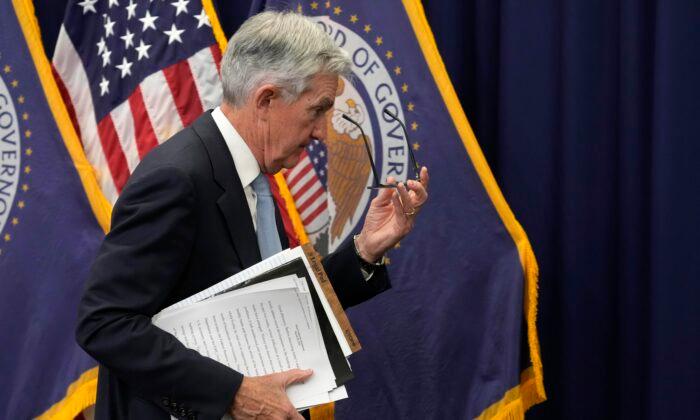NEW YORK—The Federal Reserve has raised its key interest rate yet again in its drive to cool inflation, a move that will directly affect most Americans.
On Wednesday, the central bank boosted its benchmark rate by a quarter-point to 5.1 percent. Rates on credit cards, mortgages and auto loans, which have been surging since the Fed began raising rates last year, all stand to rise even more. The result will be more burdensome loan costs for both consumers and businesses.
On the other hand, many banks are now offering higher rates on savings accounts, giving savers the opportunity to earn more interest.
Economists worry, though, that the Fed’s streak of 10 rate hikes since March 2022 could eventually cause the economy to slow too much and cause a recession.
What’s Prompting the Rate Increases?
The short answer: inflation. Inflation has been slowing in recent months, but it’s still high. Measured over a year earlier, consumer prices were up 5 percent in March, down sharply from February’s 6 percent year-over-year increase.The Fed’s goal is to slow consumer spending, thereby reducing demand for homes, cars, and other goods and services, eventually cooling the economy and lowering prices.
Who Is Most Affected?
Anyone borrowing money to make a large purchase, such as a home, car, or large appliance, will likely take a hit. The new rate will also increase monthly payments and costs for any consumer who is already paying interest on credit card debt.What’s Happening With Credit Cards?
Even before the Fed’s latest move, credit card borrowing had reached the highest level since 1996, according to Bankrate.com.
The most recent data available showed that 46 percent of people were carrying debt from month to month, up from 39 percent a year ago. Total credit card balances were $986 billion in the fourth quarter of 2022, according to the Fed, a record high, though that amount isn’t adjusted for inflation.
How Will an Increase Affect Credit Card Rates?
The Fed doesn’t directly dictate how much interest you pay on your credit card debt. But the Fed’s rate is the basis for your bank’s prime rate. In combination with other factors, such as your credit score, the prime rate helps determine the Annual Percentage Rate, or APR, on your credit card.If you don’t carry a balance from month to month, the APR is less important.
But suppose you have a $4,000 credit balance and your interest rate is 20 percent. If you made only a fixed payment of $110 per month, it would take you a bit under five years to pay off your credit card debt, and you would pay about $2,200 in interest.
What if I Have Money to Save?
After years of paying low rates for savers, some banks are finally offering better interest on deposits. Though the increases may seem small, compounding interest adds up over the years.Interest on savings accounts doesn’t always track what the Fed does. But as rates have continued to rise, some banks have improved their terms for savers as well. Even if you’re only keeping modest savings in your bank account, you could make more significant gains over the long term by finding an account with a better rate.
While the biggest national banks have yet to dramatically change the rates on their savings accounts (clocking in at an average of just 0.23 percent, according to Bankrate), some mid-size and smaller banks have made changes more in line with the Fed’s moves.
Will This Affect Home Ownership?
Last week, mortgage buyer Freddie Mac reported that the average rate on the benchmark 30-year mortgage edged up to 6.43 percent from 6.39 percent the week prior. A year ago, the average rate was lower: 5.10 percent. Higher rates can add hundreds of dollars a month to mortgage payments.
Rates for 30-year mortgages usually track the moves in the 10-year Treasury yield. Rates can also be influenced by investors’ expectations for future inflation, global demand for U.S. Treasuries, and what the Fed does.
What if I Want to Buy a Car?
With shortages of computer chips and other parts easing, automakers are producing more vehicles. Many are even reducing prices or offering limited discounts. But rising loan rates and lower used-vehicle trade-in values have erased much of the savings on monthly payments.Since the Fed began raising rates in March 2022, the average new-vehicle loan rate has jumped from 4.5 percent to 7 percent, according to Edmunds data. Used vehicle loans dropped slightly to 11.1 percent. Loan durations average around 70 months—nearly six years—for new and used vehicles.
Largely because of rate increases, the average monthly payment for both new and used vehicles has risen since March 2022, Edmunds says. The average new vehicle payment is up $72 to $729, Edmunds says. For used vehicles, the payment rose $20 a month to $546.
The higher rates will keep out of the market people who have the ability to wait for more favorable terms, said Joseph Yoon, Edmunds’ consumer insights analyst.
“But with inventory levels improving, it’s a matter of time before discounts and incentives start coming back into the equation,” attracting more buyers, Yoon said.
New vehicle average prices are down from the end of last year to $47,749. But they’re still high compared with even a year ago. The average used vehicle price dropped 7 percent from last May’s peak, to $28,729, but prices are edging back up.
Financing a new vehicle now costs $8,655 in interest. Analysts say that’s enough to chase many out of the auto market.
What About My Job?
The nation’s employers kept hiring in March, adding a healthy 236,000 jobs. The unemployment rate fell to 3.5 percent, just above the 53-year low of 3.4 percent set in January. At the same time, the report from the Labor Department suggested a slowdown, with pay growth also easing.Some economists argue that layoffs could help slow rising prices, and that a tight labor market fuels wage growth and higher inflation.
Will This Affect Student Loans?
Borrowers who take out new private student loans should prepare to pay more as rates increase. The current range for federal loans is between about 5 percent and 7.5 percent.That said, payments on federal student loans are suspended with zero interest until summer 2023 as part of an emergency measure put in place early in the pandemic. President Joe Biden has also announced some loan forgiveness, of up to $10,000 for most borrowers, and up to $20,000 for Pell Grant recipients—a policy that’s now being challenged in the courts.






